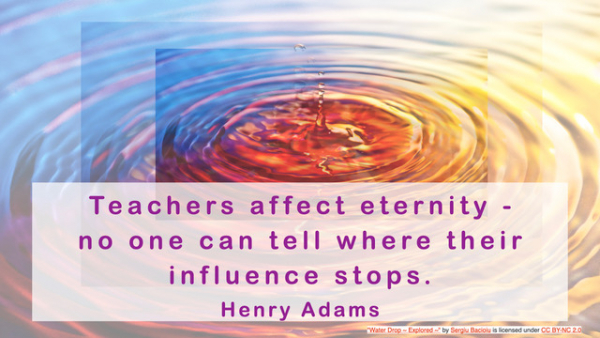At one of Pilgrims’ online café gatherings, where teachers from all over meet to share views on education we were invited to choose a quotation which resonated with us and share our views with the teachers present. This is the quotation I chose:
Teachers affecting eternity is a lot to say and a teacher or two may feel uncomfortable with this idea. Yet, teachers have always been thought of as key players in learners’ education. Ginnot (1972) wrote about teachers having the power to make a child’s life joyous or miserable, responsible for crises being escalated or deescalated, children humanised or dehumanised according to how they responded. It can be disheartening to view learners in such a powerless light and teachers in such a powerful one. Hattie (2003) found out that the major source of impact in students’ learning is what teachers know, do and care about. Given that, it may be worth reviewing our role.
Aware that their role is pivotal, teachers have endeavoured to humanise, empower and enable through their teaching. Underhill (1999) pointed out some of the aspects involved in teaching to humanise, such as the teachers’ presence, their movements, the quality of their attention, and the degree of openness they showed. Effective teaching and leadership skills (Kouses & Posner, 2012; Kyriacou, 2014) state the importance of building teams with learners, parents and colleagues, setting shared goals, setting up congruent learning environments, and fostering interaction. Over the last few years teachers have learnt what it takes to teach more effectively.
Inclusive education
Yet, no teaching can be called effective unless all learners are on board, unless there is equity. No teaching can be called effective unless it is inclusive. Inclusion entails viewing the education of all learners as having equal importance (Stadler-Heer, 2019) regardless of race, ethnicity, age, gender, sexual orientation, ability, religion, socio-economic background and any other aspect which may cause segregation. Inclusion as a principle runs through policies, leadership, curriculums, teaching, organisation, resources and assessment (Ainscow, 2020; UNESCO, 2017). As the piece of sculpture displayed in a street in Arcachon, a seaside resort in southwest France, artfully shows, inclusion honours and harnesses diversity to create possibility.
An inclusive pedagogical approach
How do we create possibility, how can all learners participate without any marginalisation? Aware that diversity per se does not guarantee inclusion, since within diversity there may live the oppressed and the oppressor (Banegas et al., 2021), I approach this question eager to find out contextualised ways of working with diversity rather than a one-size-fits-all set of strategies. In English language teaching (ELT) there seem to be very few examples of inclusive pedagogy understood as an everybody approach, away from planning for most learners and thinking of “something else” for some others (Black-Hawkins, 2017).
Attempting to affect eternity does sound like too much, but might encourage us think together about how to strengthen our inclusive practices for the benefit of all learners (Black-Hawkins et al., 2021), enhancing their identities and diverse ways of approaching learning to ensure quality education for all in search of social justice (UN, 2016).
References
- Ainscow, M. (2020). Promoting inclusion and equity in education: lessons from international experiences. Nordic Journal of Studies in Educational Policy, 6(1), 7-16.
- Banegas, D., Beacon, G., & Pérez Berbain, M. (Eds.) (2021). International Perspectives on Diversity in ELT. Palgrave.
- Black-Hawkins, K. (2017). Understanding inclusive pedagogy: Learning with and from teachers, In V. Plows, & B. Whitburn (Eds.), Inclusive Education: Making Sense of Everyday Practice (pp. 13-30). Sense Publishers.
- Black-Hawkins, K., Maguire, L., & Kershner, R. (2021) Developing inclusive classroom communities: what matters to children?, Education 3-13. DOI: 10.1080/03004279.2021.1873398
- Ginott, H. G. (1972). Teacher and child: A book for parents and teachers. Macmillan.
- Hattie, J.A.C. (2003, October). Teachers make a difference: What is the research evidence? Paper presented at the Building Teacher Quality Research Conference, Melbourne. http://research.acer.edu.au/research_conference_2003/4/
- Kouzes, J., & Posner, B. (2012). The Leadership Challenge. Jossey-Bass.
- Kyriacou, C. (2014). Effective Teaching in Schools. OUP.
- Stadler-Heer, S. (2019). Inclusion. ELT Journal, 73(2), 219-222.
- UN (2016). Goal 4: Ensure inclusive and quality education for all and promote lifelong learning. Retrieved from https://goo.gl/fZ5kEZ
- Underhill, A. (1999). Facilitation in language learning. In J. Arnold (Ed). Affect in Language Learning, (pp. 125 -141). CUP.
- UNESCO (2017). A guide for ensuring inclusion and equity in education. UNESCO.
About Mercedes
Mercedes Pérez Berbain is teacher educator and researcher; former lecturer at I.S.P. J. V. González and I.E.S. J. R. Fernández Schools of Education in Buenos Aires. She holds an MA in Education with Distinction from Oxford Brookes University, UK and a degree in Education and ICT from The Ministry of Education in Argentina. She has been training teachers both in Argentina and in the UK for more than 20 years. She is an OUP, ESSARP (Arg) and Pilgrims (UK) trainer. She has written teaching materials for Pearson and OUP, and is interested in inclusion, leadership and young learners.
Contribute to the blog
If you are a member of IATEFL and would like to contribute to the blog, we’d love to hear from you at [email protected]. We’re looking for stories from our members, news about projects you’ve been involved in, and anything else you think those connected to English language teaching would be interested in reading. We look forward to hearing from you! If you’re not a member, why not join us? Click here to see our Blog Guidelines and Ideas.



